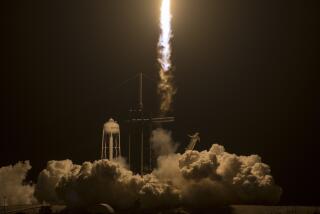Joint Caused Shuttle Disaster, NASA Decides : But Why It Happened May Never Be Known
- Share via
WASHINGTON — The presidential commission on the Challenger disaster received evidence Friday confirming that a rocket rupture caused the space shuttle explosion but casting doubt on whether the intricate mechanical mystery of what went wrong within the rocket itself can ever be solved.
National Aeronautics and Space Administration officials told commissioners that a careful system-by-system analysis had eliminated all other shuttle components as potential causes of the Jan. 28 explosion, leaving only a long-suspected joint between two lower sections of the craft’s right-hand rocket as the trigger point.
New Film of Rupture
The NASA officials showed a newly compiled film of the 73-second flight, composed of still and moving pictures taken by scores of cameras at the launching site. It depicted with great detail a puff of smoke signaling the joint’s initial rupture and--in the mission’s last 15 seconds--the rupture’s rapid growth into a giant blowtorch, which seared through the adjoining external fuel tank to ignite a potent mix of gases.
In addition, commissioners were told that the list of possible causes for the rupture of the right-hand rocket has been whittled down to half a dozen, ranging from the effects of cold weather on synthetic rubber O-rings that are supposed to seal the joint to defects caused by improper assembly of the rocket’s four main sections.
However, the NASA witnesses cautioned that surprisingly unpredictable results of post-accident tests on simulated rocket joints indicate that it will be extremely difficult, if not impossible, to further pinpoint the cause of the rupture.
“The tests have indicated that . . . the ways in which the joint might fail are quite variable and even unpredictable,” commission member Neil A. Armstrong, a former astronaut, said.
Nonetheless, commissioners appeared delighted that NASA witnesses, who have stubbornly resisted any attempts to publicly voice their long-held suspicion that the rocket joint caused the explosion, finally were willing to eliminate a theoretical leak of the shuttle’s external fuel tank and several other potential causes.
“I believe we have eliminated all the other possibilities,” Wayne Littles, a top engineer, said.
After the hearing, commissioners said that the principal challenge of their 120-day assignment was to nail down the cause to a point where appropriate and all-inclusive remedies can be recommended. They believe that, with the testimony Friday, this has been accomplished.
“When we first started, I wasn’t sure we would get this far,” commission Chairman William P. Rogers said.
Rogers and other commissioners indicated that further narrowing down the cause of the rupture is less important than isolating the overall joint as the culpable component. Although further tests over the next two weeks are intended to better establish what went wrong inside the joint, commission members said they intend to recommend that the inevitable redesign of the rocket joint incorporate changes that would address all existing failure possibilities.
“You don’t have to narrow it down anymore,” said one commission member, who asked not to be identified. “You are going to have to fix them all anyway.”
Stanford physicist Arthur B. C. Walker Jr. added: “I can imagine there will be more than one thing that will have to be done (to fix the joint to the commission’s satisfaction). Anything you can’t rule out you have to fix.”
Hardened Putty
One theory is that freezing overnight temperatures stiffened a putty designed to protect the O-rings from the jet-hot propellant. The hardened putty might have kept the primary O-ring and its backup from pressurizing properly during the first fractions of a second during ignition, allowing the gas to sear a pathway through the rocket joint.
Another theory has the two O-rings suffering some erosion on ignition but regaining their seal. But, this theory holds, the seal was lost later--either when the spacecraft was rocked by abnormally sharp wind shears 50 seconds into flight or, at 58 seconds, when it encountered the maximum pressures of aerodynamics and gravity it faced on liftoff.
This theory might explain one of the most baffling inconsistencies in the evidence--the fact that a puff of black smoke was detected at the joint in the first three seconds of flight, but no additional evidence of a rupture appeared until 55 seconds later.
Morton Thiokol Inc., the firm that builds the 149-foot rockets, already was considering 43 design modifications at the time of the Challenger explosion, and, in the months before the fateful flight, a small number of engineers at the firm had begun recommending that the shuttle fleet be grounded until ways to improve joint seals were implemented.
The reusable solid rockets, which fire for two minutes to hurl the shuttle into orbit, are built in sections so that they can fit on rail cars for transportation from a Utah factory to the Kennedy Space Center in Florida, where final assembly occurs.
More to Read
Sign up for Essential California
The most important California stories and recommendations in your inbox every morning.
You may occasionally receive promotional content from the Los Angeles Times.














